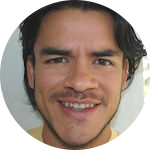
Alejandra Ortiz, a volunteer at a ground-breaking monthly pop-up clinic in Amsterdam, the Netherlands, photographed on 18 November 2018.
Before the doors open Alejandra has already laid out a loaf of bread, cheese slices, some hummus as well as a bottle of dry white wine on a long walnut wooden table that extends across the room. Her colleagues, who are also her friends, are busy hooking a thick theatrical curtain onto the ceiling to separate one room from another. On one side is a kitchenette, a desk with two chairs, and a wall covered with the image of a woman’s back in a fluorescent pink bikini. Today, this is the doctor’s office. On the other side is a table where the receptionist with mahogany-coloured hair, nutmeg skin and a smile that expands across her face sits. Alejandra’s long dining table with a dozen or so chairs is the waiting area.
“When people arrive, we write down their names on a list and serve food until it’s their turn to see the doctor. Here they eat, chat, share stories and exchange tips,” says Alejandra, lifting her flower print dress to cross her legs with great poise. “It has truly become a meeting place, a safe haven, for us.”
Since January 2018 Alejandra has been one of a team of five volunteers that organises a monthly pop-up clinic in Amsterdam for transgender and gender non-conforming people. A cross-alliance between the sex workers labour union Proud and the multicultural transgender rights group TransUnited, the clinic is a place where people can get prescriptions for hormones and HIV medication, referrals to medical specialists, judicial aid for legal name changes or to ask delicate questions about medical and social transition.
Visits to the clinic are free of charge and don’t require prior appointment, making it a much faster and more accessible alternative to the two-year waiting period that has become standard for transgender people seeking a medical transition in the Netherlands.
The only two public hospitals specialised in transgender health care in the country have been struggling to keep up with the steady rise in applications, a number now five times higher than in 2008. The long waiting period has been decried by transgender rights groups like Transvisie as causing life-threatening mental illness and self-medication among transgender people.
Word of mouth about the clinic’s fast-track referral service has spread like wildfire. The clinic’s waiting room started out hosting three to five people when it launched in early 2018; now more than 20 people attend each month, with the queue sometimes snaking outside. Part of the clinic’s magic is that it directly attends to the individual needs of the patients while hospitals follow a strict protocol of medical transition uniformly applied to all transgender people in a trajectory lasting two to three years.
“There is no tailor-made trajectory because doctors are not asking what the clients actually want or need,” says Dr. Adrie Van Diemen, the transgender endocrinologist and sexologist who pioneered the clinic. “Here we do ask those questions and most often people just want hormones and that’s it. So we give it to them.”
Outdated protocol
Also known as ‘Het Traject’ (The Trajectory), the protocol for medical transition in the Netherlands works like a scientific formula in which the client follows linear steps for treatments like hormone replacement therapy, psychological guidance and chest and/or sex reassignment surgeries, with medical experts ranging from psychologists and plastic surgeons to dermatologists and sexologists.
Over a span of three years, the established idea is that one comes out the other end as a fully transitioned woman or man. And while some people do want this, critics fear this makes cisgender (a person who identifies with the gender they were assigned at birth) bodies the benchmark of what is normal and desirable, leaving no room for other possibilities.
“The protocol dates back to the 1970s and was designed by cisgender doctors and psychologists at the time,” says Van Dieme. “But it has never been updated or revised, let alone by transgender people themselves.”
The protocol’s outdatedness is most evident in how clients are required to first pass psychological tests to diagnose whether they are truly suffering from what is clinically called ‘gender dysphoria disorder’. This is a medical term which makes a person’s feeling that their body does not correspond with the gender they identify with (so ‘gender dysphoria’) a psychological deviation or illness, hence the added ‘disorder’. Before starting any procedure, they are then tested to check if they can withstand the challenges of physical and social transition.
“Sometimes people get denied medical transition for heavily drinking,” Dr. Van Adrie says. “And who determines who is truly transgender? Not the patient.”
Because for so long transgender people have depended and relied on the very medical institutions which have historically pathologised and oftentimes dehumanised them, the initiative to take their medical care and needs into own hands marks a major milestone in the struggle for transgender rights.
At the clinic, patients do not have to wait two years or pass any psychological tests, transgender people are believed for who they say they are, and their needs are heard and met, regardless of their citizenship or legal status.
Medical and social care for all
While it serves as a major lifeline for Dutch people who cannot wait two years to medically transition, the clinic has also become a true lifesaver for transgender migrants and refugees. Most often, they start transitioning in their home countries but on arriving in the Netherlands, they are forced to stop and obtain their medication through official Dutch protocol. However, the arduous path to obtaining legal residency or refugee status in the Netherlands makes this registration virtually impossible for many people.
Alejandra, who fled Mexico’s endemic violence against transgender women in 2015, experienced first-hand what happens to people like her in the Dutch asylum system.
“I went six months without hormones when I was in the refugee camps,” she says. She then underwent an excruciating three-year legal battle to receive asylum. “They said that as long as I am not registered at a Dutch hospital, they can’t give me hormones. But because I don’t have legal residency, I can’t register.”
She has since worked together with the transgender rights organisation TNN (Transgender Network Netherlands) on a successful campaign to make sure that transgender refugees receive their hormone treatment while residing in the camps. However, the denial of treatment as well as rampant sexual assault due to the placement of transgender women in male refugee camps continues to be commonplace.
“Here doctors think that they can take that decision [of whether someone should be prescribed hormones or not] for you. They don’t understand that our need for hormones is a matter of life or death,” she adds.
After a three-year asylum procedure that Alejandra says “psychologically destroyed” her, in 2017 migration authorities forced her to either leave the country or live on the streets as an undocumented person. Her ability to ‘pass’ as a woman, authorities claimed, would shield her from any transphobic violence and therefore returning to Mexico was safe.
“I was devastated, I was lost. I didn’t know where to go,” she says. “But the girls here, they picked me up and took me in. They took care of me.”
Since joining the team, Alejandra has become a key figure in raising awareness about the abuse transgender refugees face in the Netherlands while also playing a vital role in helping newcomers like her access hormones, HIV tests and legal assistance
“I am illegal here but this community, to which I now belong, fills me” Alejandra says. “Because this is not just a clinic. What we are building here is community.”
Building a safe space
Between bodies lurking in and out neon light windows, tourists bumbling over pebbled streets, and the deep ring of Amsterdam’s Old Church bells lies the Prostitute Information Center. This small autonomous space was founded by sex workers to teach tourists and students about the history and reality of sex work from the perspective of those who practice it.
It’s also where the ambulant trans clinic found its monthly shelter, a telling sign of the powerful role sex workers play in uplifting and taking care of their community and allies.
Dinah Bons, a trailblazing sex workers’ rights, HIV/AIDS and transgender rights advocate at home and abroad, could broadly be considered the mother hen of this community.
In her role as board member of the sex workers union Proud, Bons saw how “sex workers, transgender people, refugees, migrants, people of colour, and particularly those at the intersections, are being left out of proper care,” she says.
Despite the Dutch policy of denying work permits to citizens outside of the European Union for sex work, nearly half of all sex workers in the country are non-EU migrants.
Access to healthcare, including vital HIV medication and hormone treatment can often be precarious for this segment of society because, unless in the case of an emergency, the Dutch medical system exclusively serves those with legal residency. The lack of awareness, language barriers, social isolation and limited mobility further leaves the healthcare of many undocumented sex workers unattended, according to research from the European migrant sex workers group Tampep.
“People who are stuck in refugee camps, people who are undocumented and have HIV, who are transgender and don’t get their HIV medication or don’t get their hormones,” Bons says. “These people are set up to die.”
With this sense of emergency, Bons reached out to her network of medical professionals, sex worker activists and transgender advocates, and erected the clinic.
Not just for medical care, but for “everything” Bons says. “What we need right now is safety – a safe space by and for transgender people.”









